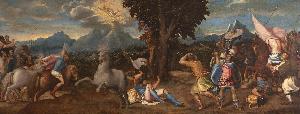Giulio Licinio Il Romano
Giulio Licinio Il Romano;Giulio Licinio
Place: Pordenone
Born: 1527
Death: 1593
Biography:
Giulio Licinio, also known as Giulio Licinio il Romano, was a renowned Italian painter from the Renaissance period. Born in 1527 in Pordenone, Italy, he died in Praga after 1593. As a member of a family of artists, Giulio made his apprenticeship with his uncle Bernardino and worked as an assistant to him.
Early Life and Training
Giulio's early life and training played a significant role in shaping his artistic style. He was part of a family of artists and learned the techniques of painting from his uncle Bernardino. This training helped him develop his skills and eventually become a skilled painter.
Notable Works
Some of Giulio's notable works include The Conversion of Saint Paul, painted in 1555, and The Rape of the Sabines, which was probably intended to be inserted into wall panelling. He also painted Pietà with mourning angels for the altar of the new court chapel in the west wing of the castle of Graz in 1571/72.
Artistic Style
Giulio's artistic style was characterized by his use of bold colors and dramatic compositions. He was known for his manierist style, which was a characteristic of the Renaissance period. His paintings often featured complex scenes and figures, showcasing his skill and technique.
Museums and Collections
Giulio's works can be found in various museums and collections, including the Galleria Sabauda in Turin, Italy. This museum houses a wide range of artworks from the 14th to the 18th centuries, featuring artists such as Duccio di Buoninsegna, Sandro Botticelli, and Filippino Lippi.
- Galleria Sabauda, Turin, Italy
- Giulio Licinio Il Romano
- Discovering the Artworks of East Lothian Council Museums, United Kingdom
works by Giulio can be found in various collections and museums, making him a significant figure in the art world. His legacy continues to inspire artists and art lovers alike.
Conclusion
In conclusion, Giulio Licinio Il Romano was a talented painter from the Renaissance period. His manierist style and bold compositions make his works stand out. With his notable works and contributions to the art world, Giulio remains an important figure in the history of art.

